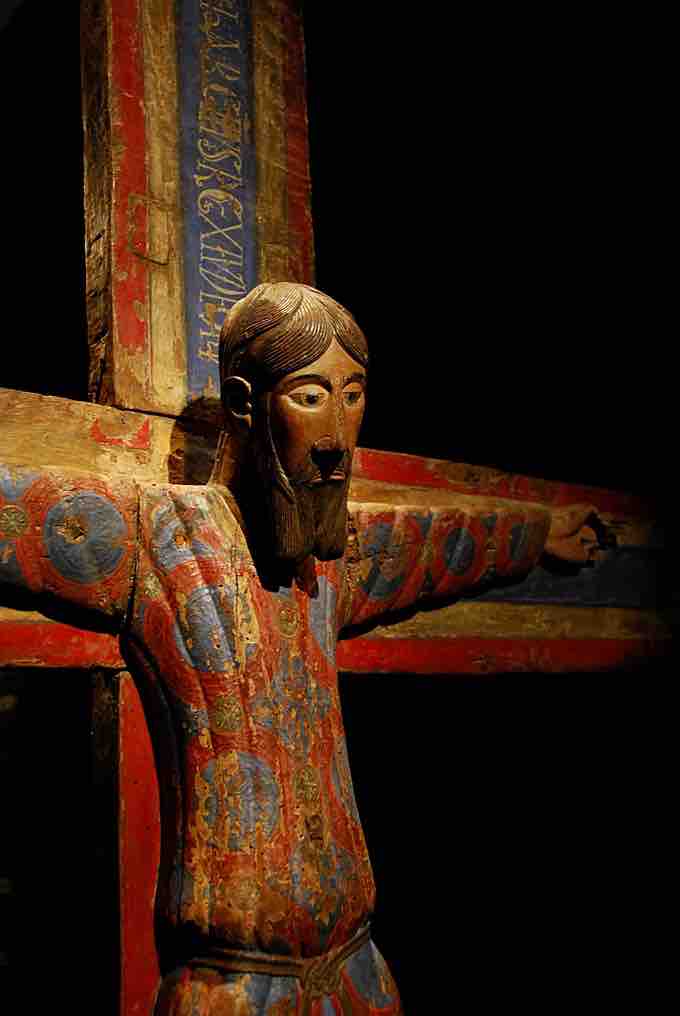Overview: The Majestat Batlló
The Majestat Batlló, or Batlló Majesty, is a 12th century Romanesque polychrome wood carving now held in the Museu Nacional d'Art de Catalunya in Barcelona, Catalonia. Carved wooden images were a fundamental element in churches as objects of worship, and one of the most elaborate types in Catalonia was the Christ in Majesty: images of Christ on the Cross that symbolize his triumph over death. The most outstanding of these is the Majestat Batlló, which is also one of the finest and best-preserved examples of Catalan sculptures.

Majestat Batlló
The Majestat Batlló is a large 12th century Romanesque wooden crucifix, now in the National Art Museum of Catalonia in Barcelona. It is one of the most elaborate examples in Catalonia of an image of Christ on the Cross symbolizing his triumph over death.
Symbolism and Description
The Majestat Batlló is a large wooden crucifix that presents Christ bearing his suffering with noble stoicism. It is a triumphant Christ wearing a colobium, or a long, sleeveless tunic. Although the corners of his mouth turn slightly downward, Christ's open eyes and unfurrowed brow create the impression of a self-possessed impassivity. A Latin inscription above his head reads, "JHS NAZARENUS REX IUDEORUM" ("Jesus of Nazareth King of the Jews"), as in biblical accounts (Matthew 27:37, Mark 15:26, Luke 23:38, John 19:19).
One of the striking features of the Batlló Majesty, compared to others, is the well-conserved polychromy. Christ's colobium, in imitation of rich oriental silk, is decorated with blue floral designs surrounded by circular red frames embellished with dots and circles. A thin belt with an elaborate interlace knot pulls the tunic in above Christ's hips, making the fabric above it swell out slightly and curving the path of its flat, wide vertical folds. Such robes are linked with royal and priestly functions and conveyed a message of strength to the viewing audience. They can be seen as a visualization or image of the Apocalyptic Christ from the Book of Revelation.
The frontal geometric composition of the tunic decorated in circles and floral motifs is reminiscent of the refined Byzantine and Hispano-Moorish fabrics held in such high esteem in the Christian West during this time. The great reference for this type was the Volto Santo in Lucca (Tuscany, Italy), which was regarded as having miraculous origins and was the object of pilgrimage and extraordinary devotion from the end of the 11th century. The iconographic tradition of Jesus in a colobium dates to 586 CE, in a manuscript of the Syriac Gospels called the Rabbula Gospels, written by the monk Rabbula somewhere in Mesopotamia. It is thought that the tradition of depicting Christ in such costume was brought to Catalonia by artisans from Pisa, who arrived in 1114 to help Ramon Berenguer III, Count of Barcelona, in his conquest of the Balearic Islands.
Chronology
The chronology of the Majestat Batlló is difficult to date, but the inscription on the cross and the painting could be placed in the 11th century. However, other authors date it back to the 12th century, based on the painting's similarity to ones seen in the area of Ripoll, mid-12th century. The tunic also has an analogy with an Islamic motif abacus of the cloister of the abbey of Saint-Pierre de Moissac, which seems to prove the spread during the Romanesque period.